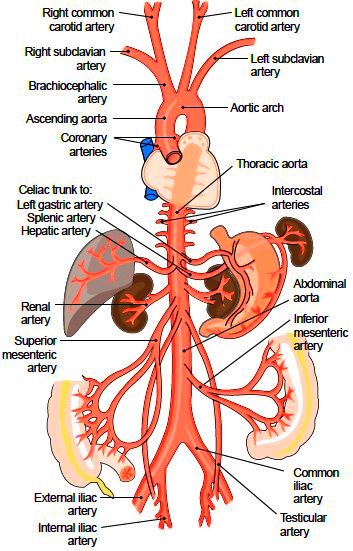Related Subjects:
|Aorta
|Acute Coronary Syndrome (ACS) General
|Aortic Dissection
|Acute Heart Failure and Pulmonary Oedema
|Aortic Regurgitation (Incompetence)
|Aortic Stenosis
|Aortic Sclerosis
|Transcatheter aortic valve implantation (TAVI)
Overview of the Aorta
The aorta is the largest artery in the human body, originating from the left ventricle of the heart and extending down to the abdomen where it branches into smaller arteries. It plays a crucial role in delivering oxygenated blood from the heart to the rest of the body.
Anatomy of the Aorta
- Ascending Aorta:
- Begins at the aortic valve of the heart.
- Gives rise to the coronary arteries, which supply blood to the heart muscle.
- Aortic Arch:
- Curves over the heart, giving rise to major arteries that supply the head, neck, and arms.
- Branches include the brachiocephalic trunk, left common carotid artery, and left subclavian artery.
- Descending Thoracic Aorta:
- Continues from the aortic arch down through the chest.
- Supplies blood to the chest wall and organs within the thorax, excluding the heart and lungs.
- Abdominal Aorta:
- Begins at the diaphragm and extends to the lower abdomen.
- Branches into the celiac trunk, superior mesenteric artery, renal arteries, and inferior mesenteric artery, supplying blood to abdominal organs.
- Ends by bifurcating into the right and left common iliac arteries, which supply blood to the pelvis and lower limbs.
Functions of the Aorta
- Oxygenated Blood Distribution:
- The primary function of the aorta is to transport oxygen-rich blood from the left ventricle to the rest of the body.
- Pressure Reservoir:
- The elasticity of the aorta allows it to act as a pressure reservoir, maintaining blood pressure during diastole (heart relaxation phase).
- Pulse Dampening:
- The aorta helps to dampen the pulsatile output of the heart, providing a more steady flow of blood to the peripheral tissues.
Clinical Relevance
- Aortic Aneurysm:
- A dilation or bulging of a portion of the aorta, which can lead to rupture if untreated.
- Commonly occurs in the abdominal aorta (abdominal aortic aneurysm) or the thoracic aorta (thoracic aortic aneurysm).
- Risk factors include hypertension, smoking, and genetic predisposition.
- Symptoms may be absent until rupture; screening and monitoring are crucial for at-risk individuals.
- Treatment may involve surgical repair or endovascular stenting.
- Aortic Dissection:
- A serious condition where there is a tear in the inner layer of the aorta, causing blood to flow between the layers of the aortic wall.
- Can lead to rupture or decreased blood flow to organs.
- Symptoms include sudden, severe chest or back pain.
- Treatment often involves emergency surgery.
- Atherosclerosis:
- Build-up of plaques in the aortic wall, leading to reduced elasticity and potential obstruction of blood flow.
- Risk factors include high cholesterol, hypertension, smoking, and diabetes.
- Can lead to conditions such as coronary artery disease, peripheral artery disease, and stroke.
- Management includes lifestyle changes, medications, and potentially surgical interventions.
- Coarctation of the Aorta:
- A congenital condition characterized by narrowing of the aorta, leading to increased blood pressure before the narrowing and decreased pressure beyond it.
- Symptoms may include hypertension, headache, muscle weakness, and heart failure in severe cases.
- Treatment often involves surgical repair or balloon angioplasty.
- Aortic Valve Disorders:
- Conditions such as aortic stenosis or aortic regurgitation can affect blood flow from the heart into the aorta.
- May require valve replacement or repair surgery.
Summary
The aorta is the main artery responsible for transporting oxygenated blood from the heart to the rest of the body. It has several sections, each supplying different regions with blood. The aorta's elasticity allows it to maintain blood pressure and steady blood flow. Clinical conditions such as aortic aneurysms, dissections, atherosclerosis, coarctation, and valve disorders can significantly impact its function and require careful management and treatment.
